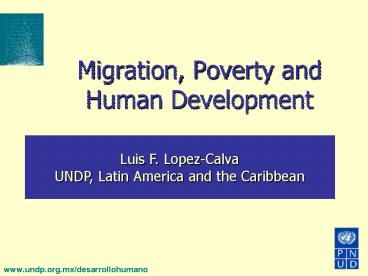Migration, Poverty and Human Development - PowerPoint PPT Presentation
1 / 25
Title:
Migration, Poverty and Human Development
Description:
Migration, Poverty and Human Development Luis F. Lopez-Calva UNDP, Latin America and the Caribbean Migration and Human Development The poorest people do not represent ... – PowerPoint PPT presentation
Number of Views:44
Avg rating:3.0/5.0
Title: Migration, Poverty and Human Development
1
Migration, Poverty and Human Development
Luis F. Lopez-Calva UNDP, Latin America and the
Caribbean
2
Contents
- Migration and human development
- Migration and local conditions
- Migration abroad and human development
- Migration and remittances
- Migratory policy in Mexico
3
- Migration
- and
- Human Development
4
The importance of migration
- 11 million people born in Mexico lived in the US
in 2005 - Remittances were 3.5 of the GDP in 2005
- 2.7 of the population changed residence from
one State to another in 2005
5
Migration and Local Conditions
6
- The poorest people do not represent a high
migration group
7
Probability of migration and per capita income
8
Poverty and migration
- The poor are not the main group that migrates
- but migration among the poor is increasing
- The poor migrate in response to economic shocks
- but as social networks expand the poor migrate
as a planned decision
9
Migration as an individual decision
- In 2005, almost 11 million people born in Mexico
lived permanently or temporarily in US. - Evidence shows that the principal trigger to
migrate is the development gap between regions. - According to the theory of Spatial Localization
differentials include not only salaries but also
another indicators of living conditions in
general.
10
Migration as an individual decision
- The migration decision reveals the evaluation of
cost-benefit individuals make to several
dimensions like economic welfare, cultural
change, family welfare, social and community
rights. - However, the migration decision involves
imperfect information and idiosyncratic
conditions that affect the final decision.
11
Cost of Migration
- Practically all migrants crossing without
documents need help from a coyote (pollero). - The average cost of a coyote in 2003 was
US1,600. - The relationship between the demand for coyotes
and their cost is controversial though it has
been found that elasticity is low. This suggests
that coyote price could be a second order
parameter. - This argument supports the hypothesis that
policies of border tightening do not have the
expected effect in the reduction of migratory
flows
12
Cost of Migration
Price and percentage of migrants using
coyote (migrants crossing without documents)
13
Effects of Border Tightening
- Border tightening policies since the 90s DID NOT
reduced migration flows - The main effects are
- People stay longer, they do not go back
(reduction in circular seasonal migration) - They bring their families
- The cost of migration (coyotes and other costs)
increases - Routes change and conditions worsen
14
Migration and Education
- Historically, migrants have, on average, higher
levels of education than those non-migrants in
their communities, though lower than in the
receiving places in the United States - The above is especially true for women, a
population group where migrants have a schooling
differential higher than in the case of men with
respect to those non-migrants within their own
communities - Migration tends to reduce inequality in levels
of education, at least in the short-run
15
Migration and Education
- Remittances promote greater investment in primary
and secondary education for the sons of migrant
families, with a favorable bias for girls and - Migration discourages investment in middle-high
and high levels of education (individuals of 16
to 18 years of age) in communities with a migrant
tradition.
16
Migration and Health
- The relationship between migration an health is
overly complex. - It is necessary to examine the process in three
different moments the origin, the route to the
north, and the destination. - Migration has negative consequences for the
family dynamics of those staying (depressive
syndromes, anxiety and other mental disorders). - Remittances have been shown to have a positive
effect on childrens health (lower infant
mortality and higher weight at birth)
17
Migration and Remittances
18
Remittances and development
- There is an inverse U-shaped relationship
between human development and migratory intensity.
Human development index and migratory intensity
index by municipality, 2000.
19
Income and Remittances
- The states receiving more income from
remittances as a share of its GDP are Michoacan
and Zacatecas, followed by Oaxaca and Guerrero
20
Program 3x1
- The program 3x1 for migrants is created in 2002
by the Mexican Federal government. - Supporting initiatives of productive projects
and social infrastructure from migrants abroad. - Beneficiaries are people living in poverty in
any of the 31 states of Mexico. - Projects are funded as follows 25 from federal
Govt 25 from migrant organizations 50 from
local and state governments.
21
(No Transcript)
22
(No Transcript)
23
Final Comments
24
Final Comments
- Migration is a way of exercising the effective
freedom of people. - Public policy should favor that the exercising
of such an option is a legitimate way of
individual development. - The purpose of any development strategy must be
the raising of welfare and freedom levels for
concrete individuals in a sustainable way.
25
Final Comments
- The most commendable migratory policy is a
strategy of sustainable local development - Only convergence through regional development
strategies can eventually stabilize migration
flows































